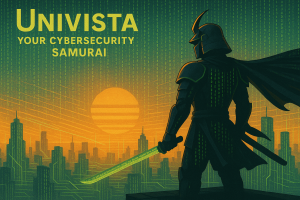
As you discovered in our last post, AI and the future of Cybersecurity, AI is making cybersecurity more difficult due to the speed and sophistication it brings to malicious attacks, causing traditional malware prevention technologies and methodologies to not be enough to keep your organization safe. This article shifts focus to the broader threat landscape of 2025, focusing on the most significant threats observed so far this year and projects what we should prepare for through the end of 2025 and into 2026. As you’ll see, it will be challenging to stay secure thanks to the deployment of AI and other new technologies. UniVista continues to be a leader in Cybersecurity with its support agreements that include leading cybersecurity products from Cisco, Huntress, and Knowbe4.
Top Cybersecurity Threats Observed in 2025 (So Far)
- AI-Enhanced Phishing and Social Engineering
The landscape of cybersecurity threats has evolved significantly in 2025, with AI-enhanced phishing and social engineering becoming increasingly sophisticated. One of the most alarming tactics involves the use of deepfakes and voice cloning to impersonate trusted individuals. For instance, a finance employee at Arup was deceived into transferring $25 million during a video call that featured AI-generated deepfakes of the CFO and colleagues. Sources: CrowdStrike & The Hacker News
How to Combat This Threat:
Conduct regular phishing simulations and awareness training using an application like KnowBe4.
Use a desktop application like Cisco Umbrella to block malicious domains and phishing links.
Use a next generation security application like Huntress AV to detect and respond to suspicious endpoint behavior.
- Ransomware-as-a-Service (RaaS) Evolution
Ransomware-as-a-Service (RaaS) platforms have evolved to become more accessible, allowing even low-skill attackers to launch sophisticated campaigns. New tactics include: AI-generated phishing (which creates personalized and convincing emails that mimic internal communications), double extortion (where data is encrypted and threatened to be leaked unless a ransom is paid), and hybrid work exploitation (targeting home networks and personal devices with weaker security). Sources: Proactive Data & Techopedia
How to Combat This Threat:
Keep all systems patched and up to date or use an MSP like UniVista to guarantee that your systems will be properly patched.
Make sure that your desktop security applications include ransomware behavior detection and rollback features like Huntress AV.
Train employees with KnowBe4 to recognize suspicious attachments and links.
- Zero-Day Exploits in Widely Used Software
Thanks to AI, zero-day threats are becoming more widely exploited. High-profile vulnerabilities in platforms like Microsoft SharePoint have been targeted by attackers before patches were released, leading to substantial security breaches. These exploits have allowed malicious actors to gain unauthorized access to sensitive data and disrupt operations, highlighting the critical need for timely patch management and robust security measures to mitigate such threats. Sources: CPO Magazine & Bleeping Computer
How to Combat This Threat:
Apply patches as soon as they are tested, validated and released. UniVista does this for all systems that it supports.
Use a security application that can block exploit delivery domains like Cisco Umbrella.
Monitor endpoints for unexpected behavior with an application like Huntress AV.
- Cloud Misconfigurations and API Exploits
APIs, two software systems “talking” to each other by using a set of definitions and protocols, have emerged as a leading cause of cloud breaches due to misconfigurations. For instance, T-Mobile faced unauthorized access to customer data due to internal APIs that were exposed to hackers. Facebook also experienced data exposure from over-permissive access tokens and unauthenticated endpoints. Volkswagen Cariad also suffered a breach when a misconfigured system hosted by Amazon exposed the GPS and contact data of 800,000 EV owners. Common misconfigurations contributing to these breaches include unauthenticated endpoints, over-permissive access tokens, forgotten staging/test APIs in production, and a lack of rate limiting and schema validation. Sources: Business News Today & Cybersecurity News
How to Combat This Threat:
Verify, or employ an organization like Univista to verify, that your key vendors conduct regular cloud configuration audits for your key hosted applications.
- Supply Chain Attacks
In 2025, cybercriminals have increasingly targeted third-party vendors to infiltrate larger organizations. By compromising these vendors, attackers can bypass direct defenses and gain access to their ultimate targets, often with devastating results. For instance, United Natural Foods experienced a cyberattack that led to food shortages at Whole Foods and multiple threat actors exploited vulnerabilities in the Ivanti VPN to breach Ivanti’s customer enterprise networks. Sources: CRN & Daily Security Review
How to Combat This Threat:
Vet, or employ an organization like Univista to vet your third-party vendors for their cybersecurity practices.
Emerging and Projected Threats for Late 2025 into 2026
- Autonomous AI Malware
Autonomous AI malware is a significant emerging threat in cybersecurity that could completely change the threat landscape. This type of malware can adapt and make decisions in real time, which allows it to evade traditional defenses. It uses advanced AI techniques to analyze its environment and modify its behavior accordingly, making it much harder to detect and neutralize. Sources: Goldilock & ProDigitalWeb
How to Combat This Threat:
Use a desktop security like Huntress AV that can perform behavior-based malware detection.
Use a desktop security like Cisco Umbrella to block known malicious command-and-control traffic.
Keep all systems patched and up to date or use an MSP like UniVista to guarantee that your systems will be properly patched.
- Quantum-Ready Cryptographic Threats
To explain Quantum computing completely would require a blog unto itself. Just know that Quantum computing is so powerful that it has the potential to make child’s play of all current encryptions. Imagine the potential of having all encrypted data exposed. That is how big a threat Quantum Computing is to all classic encryptions. Sources: IoT World Today & Cybersecurity News
How to Combat This Threat:
Verify that your vendors are actively testing post-quantum cryptographic algorithms. The National Institute of Standards and Technology (NIST) has released encryption standards for Quantum Cryptography.
Reverify encryption standards on a regular basis.
Conclusion
As you can see, 2025 has offered a significant change to the Cybersecurity landscape and 2026 will only grow on the progress malicious actors have already made. The best thing you can do is stay active and educated in the security arena, or partner with an MSP like UniVista. We focuse on the best security practices in the market and use applications from the best vendors in the Cybersecurity space. If you do have questions about this or any other subject, please reach out to UniVista at 512-832-6209, option 2 or contact us at [email protected].
